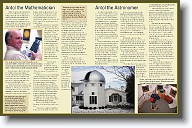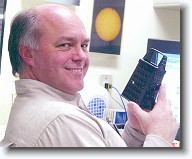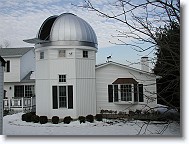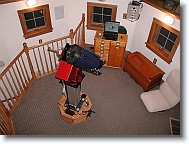
Math Matters
Publication:
[
jpg
|
pdf
]

This image commemorates Antol being the second
recipient of IBM's "I Innovate" award. Why is he holding
a cheese grater? And why does he have 4 of them in his
office? Ask him when he visits campus October 8, 2009.

Exterior and interior shots of Stargate 4173 at Grimaldi
Tower. Curious about the name? Want to learn more?
Visit http://www.stargate4173.com/

|
|
Antol the Mathematician
|
Antol the Astronomer
|
If there is anyone who could return
to campus to talk with undergraduate
students about the love of mathematics
coupled with the understanding that
there is life outside mathematics, and
the vast opportunities expressed by the
intersection of these two things, it would
be IBM senior software engineer and ISU
alumnus Robert Antol (MATH '78).
When he visits in the Fall (October
8, 2009), he plans to encourage students to
entertain any possible job opportunities,
to make sure they have an appropriate
minor, and to realize that industry will
see them as a larger person than just a
person who understands math.
Antol first arrived on campus in 1974
with interests in biology, entomology and
mathematics. Needing to concentrate
on a single subject, his fascination with
mathematics won out, although he
continued to take courses in botany and
biology. Early on, his advisor, Dr. Alan
J. Heckenbach, recommended that he
consider a minor in computer science.
Antol had little interest in computer
science, but he planned to stay on for his
Ph.D. degree so he carved a space for it
in his studies.
Although Antol intended to join the
ISU faculty, in his senior year he joined
other undergraduates in
participating in campus
career fairs. When
the IBM representative
invited him to come
interview in a town with
a funny name - Fishkill -
Antol decided that
he had nothing to lose
by accepting the free
trip to New York. But
in Fishkill, he was not
prepared for the starting
salary IBM offered:
more than his ISU
mentor Heckenbach
made after working ten
years.
Antol returned
to campus a bit
bewildered. Seeking
guidance, he listened to
Dr. Heckanbach reason,
"Why don't you go; if you don't like it,
come back."
Thirty-one years later, Antol remains
at IBM, working in an area called EDA
(Electronic Design Automation) where,
he writes, "Our mission is to develop,
deliver and support working EDA
flows through development of EDA
tools and methodologies that give IBM
microprocessor and Application Specific
Integrated Circuit designers a competitive
market advantage by providing unique
function, improved turn-around-time,
improved quality and/or lower cost
of design for chips. Some of the chips
designed with our system are now in the
Wii® and Xbox® game systems."
Does he play Wii®and Xbox®?
Laughing, he acknowledges that he does
not.
"If you were a carpenter building a
house, you would need tools like a saw,
hammer and screwdriver - without them
you would be unable to build the house,"
Antol explains. "Wii games contain chips
- they are manufactured in Fishkill. To
build chips you have to come up with
the design; engineers need tools to
design the chip - tools that take into
account timing, power consumption and
voltage - and they use tools my group
makes. Depending on the type of chip,
whether it's for a game, ATM or camera,
each feature different flows and have a
different set of requirements."
Reflecting on his professional life
experience, Antol recycles the same
direction he received from Heckenbach
all those years ago: "Make a simple
decision; try it, take a risk. Eventually
find what it is you want to do for the rest
of your life."
His own willingness to leave
academia to experiment with life in
industry has meant a great deal of job
satisfaction for Antol, who finds it "kind
of cool" to see
what products
are coming.
"There
is a working
world out
there; you have
to become a
member of it,"
Antol will tell
the students
this coming
October 8, 2009. "Be
prepared now."
|
Five feet below ground, a 5' x 5'
x 16" concrete slab embedded in the
earth offers unwavering support to
a concrete pier two feet in diameter
and 17' high. An electro-mechanical
telescoping Pier-Tech 2 is mounted
atop the concrete pier; attached to
the Pier-Tech 2 is the Paramount ME
Robotic Mount with a Meade 8 inch
LX50 Schmidt-Cassegrain telescope.
Built around the stacked pier, with
no part of the structure making
contact with the pier at any point, is
a 16' diameter Ash-Dome that, while
isolated from, is attached to Antol's
home.
Constructed in 2005, it took four
months from groundbreaking to first
light; that is, Antol explains, "The
point in time when you look through
the telescope and see first light." The
internal temperature of the dome is
the same as the outside temperature.
Heating or cooling current eddies
distort visual observation as well as
any images capured here.
It is here that stargazers Bob and
Barb Antol observe the heavens with
the push of a button.
Bob was ten years old when his
parents bought him and his brother
their first cardboard telescope, where
they peered at a magnified Saturn and
the moon. By age 14 he was lining up
a telescope on a tripod with a 35 mm
camera to photograph astronomical
objects. Through the telescope at 4:00
a.m. Antol would shoot Comet Bennett
in the early morning sky. Soon he started
taking pictures of constellations, the
moon and the sun. "The equipment
got more expensive as we got older," he
recalls.
Bob met his wife Barb, also a
mathematician, when she came to work
at IBM two years after he arrived. The
couple used to go out on the deck where
Bob taught Barb about the sky, and she
became fascinated with it. "It used to
be a bunch of points to her," Antol said.
"Now it makes more sense."
In those days stargazing involved
hoisting a 38-pound telescope, tripod and
33 pounds of equipment, lining it up,
situating it in the same spot to observe
before breaking it all down and putting it
back.
When they decided to construct the
observatory, Bob
worked with
the architect to
design the height
in the upstairs
room to allow
gazers of all sizes
to comfortably view objects both near the
horizon and straight overhead.
The telescoping Pier-Tech 2 offered
a perfect solution to these design
questions, allowing the observer to raise
and lower the pier by a push of a button.
The precision vertical adjustment keeps
the telescope polar aligned and level
while keeping the target within the field
of view.
The Antols do more observing
now because it is so convenient. The
telescope is aligned with the earth's tilt; a
special equatorial mount enables viewers
to track stars. The mount knows how
fast and far to move. "It is incredibly
accurate," Antol says, explaining that it
can track the space station or shuttle in
addition to stars.
Currently they are in the process
of upgrading to a 14.5" RCOS Ritchey-
Chretien telescope and purchasing an
astro camera that will connect to the
telescope. Antol's next project involves
photographing deep sky objects such as
nebula, globular clusters and galaxies.
Observatory visitors, like the recent
troop of Girl Scouts, sign a guestbook,
noting the time of the visit and offering a
comment. This year they expect to host
their 200th visitor.
In a presentation to colleagues at
work, who enjoy learning about one
another's hobbies, Antol told them,
"Though solar viewing is fascinating,
nighttime is the ideal time to observe,
and winter is best because it is darker
longer and the sky is crystal clear.
Summer humidity interferes with perfect
pinpoint viewing."
|
|